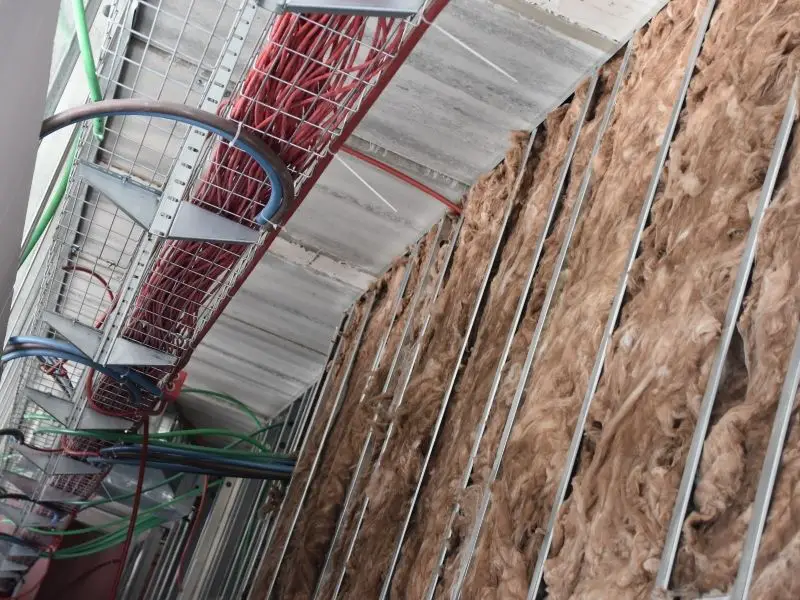Winter is around the corner and you realize that it’s about time to get some insulation done around the house. Although the attic and crawl spaces seem fit to be insulated, there’s one issue that is probably bugging you, the absence of drywall in some rooms. Insulating an open wall that does not have drywall can be insulated with batts insulation. With the help of the right tools, you can make insulation stick to an open wall with ease. In this read, we will be covering the process, requirements, and recommended insulation materials in this article.
There are many things to take into consideration, out of which insulation to go for is included. Most homeowners prefer fiberglass insulation batts to fit in their open walls. However, the procedure must be carried out carefully. Improperly installed insulation will do no good. It is essential to make sure there are no openings left unattended and the insulation fits perfectly between the studs. Two common types of batts are used for walls, tabbed and friction assisted. The former requires staples to stay in place while the latter is designed to stay put without any additional support.

How to Install Fiberglass Insulation Without Drywall
Fiberglass insulation is commonly found in both the form of rolls and batts. The difference is that rolls can be cut as needed while batts are already cut to fit standard 8 ft walls. Here is a step-by-step guide of installing insulation batts in an open wall according to the best practices:
- Firstly, put on a face mask, glasses, and a pair of gloves. Fiberglass insulation can cause irritation in the eyes and skin. For safety purposes, make sure you’re wearing long sleeves to minimize skin exposure to the fibers.
- Measure the area between the studs of a wall.
- Grab a sharp and long-bladed utility knife and cut the insulation roll accordingly. If it’s pre-cut in batts, make sure it’s a proper fit.
- While cutting the insulation, do not put too much weight on one side. This can lower the effectiveness of the material.
- Once you have the required size, position the insulation between the studs. The fluffy side must face the wall while the vapor barrier must be facing you.
Remember to not apply too much force while setting the insulation as it can get compressed and lose its effectiveness. After positioning insulation, examining every stud carefully is essential. You don’t want any open spaces or missed spots from where airflow might find its way into the house. There would be uneven studs for which you will need to cut the insulation to the required size. Once you’ve filled the walls with insulation, it is now time to fasten it.
How to Hold Insulation Without Drywall
Friction-assisted insulation does not slip out of its place but for its tabbed counterpart, fastening is needed. The most common way of holding the insulation in an open wall is through stapling it. Simply grab a staple gun and pin staples on the stud every 8-10 inches of insulation. Now you can either staple the insulation to the inner side of the studs or the front side. The best practice is to staple on the inner side so that when you put on the drywall afterward (if you plan to), the staples won’t bug the process. Another way of holding the insulation in position is by placing wires against it that fit tightly between studs. Usually, these are used for ceiling insulation but can be utilized in open walls as well.
How to Insulate Without Removing the Drywall
Let’s assume you already have closed walls and are thinking of insulating the place. However, the thought of tearing down the entire thing for insulating it appears to be the only thing stopping you from taking an action. To be fair, tearing down all the walls and putting them up back again seems to be a big hassle. If this is what’s going on in your head, then we have some good news. Insulation can be installed without removing the drywall by being blown or injected through small openings. However, this procedure should only be opted for if your drywall is in good condition and you don’t plan on renovating it anytime soon.
Insulation can be injected into studs through the drywall without having to tear the entire thing down. For this purpose, loose-fill or blown-in insulation is used. The process begins by making holes in one side of every wall. This hole is large enough to let a blower’s hose through. Insulation is blown in through the hole until the entire wall is filled up as needed. Once the space has no room left, the holes are sealed. A professional insulation installer is needed for this. Some might consider it to be an additional expense, but blown-in insulation is best handled by pros.
Here is a video showing insulating a wall with fiberglass batts without removing the drywall;
Best Insulation for Closed Walls
So, what are the top options you have for insulating without removing drywall? Here are two of the best and most widely used insulations for this purpose:
Spray Foam
Spray foam is the top candidate for filling closed walls and its effectiveness is unparalleled. As the name suggests, it isn’t exactly the traditional fluffy insulation material, rather it has a foamy texture which is a plus point. Foam can easily make its way into the tightest spaces in a wall and expand while sealing the entire area in no time. So, if your house has walls with a lot of wiring, then foam should definitely be on top of your list. Furthermore, spray foam’s superior resistance to moisture is also worth mentioning. However, due to its excellent insulation performance, spray foam is expensive.
Here is a video showing how to inject spray foam into an existing wall without removing the drywall;
Loose-fill Cellulose
Loose-fill cellulose is also a good option for insulating a closed wall. It is made from recycled paper treated with borate. The borate treatment enhances the material’s resistance to fire and pest resistance. Cellulose is environmentally friendly insulation and it doesn’t cost too much either. As far as the procedure is concerned, cellulose will be blown in through holes in the walls. For blown-in insulation, a professional is usually needed and such is the case here as well. The only drawback of using cellulose to fill a closed wall is that sometimes the insulation gets stuck to obstacles in the way. This happens due to its fluffy texture.
Here is how to install cellulose without removing drywall;
Should You Remove Drywall for Insulation or Not?
Houses that date back to the pre-WWII era were likely not insulated back then. Now that you’ve moved into a house that had several previous owners who never decided to insulate the house, you’re probably thinking about breaking the chain. However, the process of removing drywall and installing insulation then setting it back up again might seem time-consuming and too expensive. On the other hand, you have the option of insulating without putting down the drywall through injecting or blowing insulation. Both options hold somewhat of similar weight. So, how do you decide which one to go for?
Here’s the thing, both methods don’t have too much of a cost difference. You’ll be spending a good amount in removing and putting up drywall again, but you’ll also be saving money too by going for insulation batts and installing them yourself. Now, if you go for the opposite option, you’ll be spending money on having a professional come over and inject insulation into the closed walls. Note that batts are a cheaper option, so you’ll be going for relatively expensive insulation by choosing to insulate through injection. The bottom line is that both procedures have a similar cost, but you’ll save a lot of time and effort if you don’t remove your drywall.
Can a Garage Be Insulated Without Drywall?
Much like the rest of your home, yes, an unfinished garage can be insulated as well. Refer to our previous method of insulating without drywall for this purpose. However, it is recommended to put up drywall after finishing the insulation for a number of reasons; the top of them being your garage looking like just any other part of your house. Another reason is to give insulation another layer of protection from moisture. As far as the question of insulating a garage is concerned, studies have shown that it greatly minimizes the overall air that sneaks out the house from inside.
Many would suppose that insulating the garage door would be sufficient, however, this isn’t true. Even though your garage has no drywall, consider insulating at least all of the walls for the best results.
Now that you’ve bought the home of your dreams, cut down the living utility expenses by installing insulation. It might seem expensive to hire a professional and get it done without removing drywall, but it’s an investment with a profitable return. If you have the time and energy to do most of the work yourself, don’t hesitate in removing the drywall and putting up batts in there in a DIY project.
